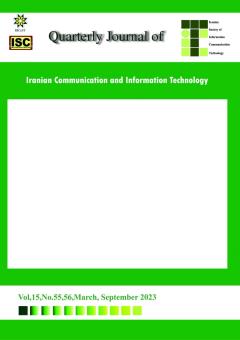Improving energy consumption in the Internet of Things using the Krill Herd optimization algorithm and mobile sink
Subject Areas : ICT
1 - Higher Education Complex of Saravan
Keywords: Wireless sensor network, Krill Herd optimization algorithm, clustering, mobile well, AFSRP protocol, IEEE802.15.4 standard.,
Abstract :
Internet of Things (IoT) technology involves a large number of sensor nodes that generate large amounts of data. Optimal energy consumption of sensor nodes is a major challenge in this type of network. Clustering sensor nodes into separate categories and exchanging information through headers is one way to improve energy consumption. This paper introduces a new clustering-based routing protocol called KHCMSBA. The proposed protocol biologically uses fast and efficient search features inspired by the Krill Herd optimization algorithm based on krill feeding behavior to cluster the sensor nodes. The proposed protocol also uses a mobile well to prevent the hot spot problem. The clustering process at the base station is performed by a centralized control algorithm that is aware of the energy levels and position of the sensor nodes. Unlike protocols in other research, KHCMSBA considers a realistic energy model in the grid that is tested in the Opnet simulator and the results are compared with AFSRP (Artifical Fish Swarm Routing ProtocolThe simulation results show better performance of the proposed method in terms of energy consumption by 12.71%, throughput rate by 14.22%, end-to-end delay by 76.07%, signal-to-noise ratio by 82.82%. 46% compared to the AFSRP protocol
[1] Akyildiz, I. F., Su, W., Sankarasubramaniam, Y., & Cayirci, E. (2002). Wireless sensor networks: a survey. Computer networks, 38(4), 393-422.
[2] Ritter, H., Schiller, J., Voigt, T., Dunkels, A., & Alonso, J. (2005, February). Experimental evaluation of lifetime bounds for wireless sensor networks. In Wireless Sensor Networks, 2005. Proceeedings of the Second European Workshop on (pp. 25-32). IEEE.
[3]Hammoudeh, M., & Newman, R. (2015). Adaptive routing in wireless sensor networks: QoS optimisation for enhanced application performance. Information Fusion, 22, 3-15.
[4]Shokouhifar, M., & Jalali, A. (2015). A new evolutionary based application specific routing protocol for clustered wireless sensor networks. AEU-International Journal of Electronics and Communications, 69(1), 432-441.
[5] Zowj, A. Y., Bongard, J. C., & Skalka, C. (2017). A Genetic Programming Approach to Cost-Sensitive Control in Wireless Sensor Networks. In Computational Intelligence in Wireless Sensor Networks (pp. 1-31). Springer, Cham.
[6] Hacioglu, G., Kand, V. F. A., & Sesli, E. (2016). Multi objective clustering for wireless sensor networks. Expert Systems with Applications, 59, 86-100.
[7] Magaia, N., Horta, N., Neves, R., Pereira, P. R., & Correia, M. (2015). A multi-objective routing algorithm for Wireless Multimedia Sensor Networks. Applied Soft Computing, 30, 104-112.
[8] Chen, D. R. (2016). An energy-efficient QoS routing for wireless sensor networks using self-stabilizing algorithm. Ad Hoc Networks, 37, 240-255.
[9] Tabatabaei, S., Rajaei, A., & Rigi, A. M. (2019). A Novel Energy-Aware Clustering Method via Lion Pride Optimizer Algorithm (LPO) and Fuzzy Logic in Wireless Sensor Networks (WSNs). Wireless Personal Communications, 1-23.
[10] Tabatabaei, S., shelebaf, A.(2020), A Novel Method for Clustering in WSNs via TOPSIS Multi-criteria Decision-Making Algorithm Logic in Wireless Sensor Networks (WSNs). Wireless Personal Communications, 1-17
[11] Tabatabaei, S., & Omrani, M. R. (2018). Proposing a method for controlling congestion in wireless sensor networks using comparative fuzzy logic. Wireless Personal Communications, 100(4), 1459-1476.
[12] Abidi, B., Jilbab, A., & Haziti, M. E. (2017). Wireless Sensor Networks in Biomedical: Wireless Body Area Networks. In Europe and MENA Cooperation Advances in Information and Communication Technologies (pp. 321-329). Springer International Publishing.
[13] Singh, R., & Verma, A. K. (2017). Energy efficient cross layer based adaptive threshold routing protocol for WSN. AEU-International Journal of Electronics and Communications, 72, 166-173.
[14] Sharma, R., Vashisht, V., & Singh, U. (2019). Fuzzy modelling based energy aware clustering in wireless sensor networks using modified invasive weed optimization. Journal of King Saud University-Computer and Information Sciences.
[15] Ebrahimi, S., & Tabatabaei, S. (2020). Using Clustering via Soccer League Competition Algorithm for Optimizing Power Consumption in WSNs (Wireless Sensor Networks). Wireless Personal Communications, 113(4), 2387-2402.
[16] Tabatabaei, S., & Rigi, A. M. (2019). Reliable routing algorithm based on clustering and mobile sink in wireless sensor networks. Wireless Personal Communications, 108(4), 2541-2558.
[17] Chen, D. R., Chen, L. C., Chen, M. Y., & Hsu, M. Y. (2019). A coverage-aware and energy-efficient protocol for the distributed wireless sensor networks. Computer Communications, 137, 15-31.
[18] S. Gorgich and S. Tabatabaei, "Proposing an Energy-Aware Routing Protocol by Using Fish Swarm Optimization Algorithm in WSN (Wireless Sensor Networks)," Wireless Personal Communications, pp. 1-21, 2021.


